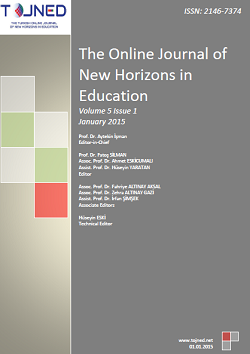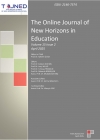TOJNED - Volume 5 - Issue 1 - January 2015
 AN EVALUATION OF TWO ESP COURSEBOOKS USING REVISED BLOOM TAXONOMY
AN EVALUATION OF TWO ESP COURSEBOOKS USING REVISED BLOOM TAXONOMY Fatma Tokoz Goktepe
Abstract: The choice of teaching materials and a coursebook that will be used in a language classroom is one of the crucial factors that may create significant differences in teaching and learning process. Hence, the teacher should pay thorough attention to determine the most appropriate teaching materials and coursebook for the particular classroom. This paper reports an analysis of two English for Specific Purposes (ESP) coursebooks in terms of language skills and subskills as a cognitive ability to choose the most appropriate coursebook between two for the specific teaching context. The criterion in the evaluation of the coursebooks will be based on four knowledge dimensions (factual, conceptual, procedural and meta-cognitive knowledge) which overlap the cognitive processes (remembering, understanding, applying, analysing, evaluating and creating) of the Revised Bloom Taxonomy. The evaluation will be quasi systematic; however, it will also be influenced by nonsystematic qualitative judgments made by the teacher. These are based on the knowledge and understanding of the teacher who knows the requirements of students in this course. The study would provide some implications based on the findings to teachers and/or material designers for effective teaching, material development and production.
 BEST PRACTICES FOR MAINTAINING DISCIPLINE IN SECONDARY SCHOOLS FOR EFFECTIVE CURRICULUM DELIVERY IN NIGERIA
BEST PRACTICES FOR MAINTAINING DISCIPLINE IN SECONDARY SCHOOLS FOR EFFECTIVE CURRICULUM DELIVERY IN NIGERIA HANNA ONYI YUSUF
Abstract: The paper highlights some of the best practices for maintaining discipline in Secondary Schools for effective curriculum delivery in Nigeria. The paper also discusses some disciplinary problems teachers may encounter in their classrooms and possible ways of tackling them. The paper concludes stating emphatically that effective enforcement of classroom discipline is a pre requisite for smooth curriculum delivery in any classroom. The paper recommended among others that teachers should maintain a calm, productive and conducive atmosphere for effective learning. Teachers should also be firm and consistent with their classroom rules and enforcement for effective and meaningful learning.
 CHALLENGES AND SUPPORT FACTORS OF MARRIED EMIRATI STUDENTS IN TEACHER EDUCATION
CHALLENGES AND SUPPORT FACTORS OF MARRIED EMIRATI STUDENTS IN TEACHER EDUCATION Patricia Stringer, Sumaya Saqr, Lilly Tennant
Abstract: The United Arab Emirates (UAE) is on the path to becoming a knowledge economy and the role women play as pioneers and innovators, not only in their own society but, also, in the global community is strongly advocated (Al-Qazzat, 2003). Involvement of women in tertiary education and in the work force is promoted despite restrictions as to the kinds of jobs they can take up and difficulties associated with socio-cultural factors. When making career choices, teaching appears to be favored as a respectable, stable job involving limited interaction with the opposite sex. This paper explores the motivational factors, challenges and support strategies of a social group of married female Emirati students undertaking their Bachelor of Education (B. Ed.) teaching degree. Using Bronfenbrenner├óŌé¼Ōäós ecological systems theory (Bronfenbrenner, 1979) and socio-cultural influences on ├óŌé¼╦£self├óŌé¼Ōäó among the various nested systems that play a role in their development, data on motivational factors, challenges and support strategies are portrayed in the findings.
 DESIGNING A MODEL OF VOCATIONAL TRAINING PROGRAMS FOR DISABLES
DESIGNING A MODEL OF VOCATIONAL TRAINING PROGRAMS FOR DISABLES Adeela Razzak, Muhammad Asif Chuadhry, MudassirSajjad, Aftab Sadiq, Muhammad Zahid Akhtar Khaki
Abstract: This study was conducted to designing a model of vocational training programs for disables. For this purpose desk review was carried out and the vocational training models/programs of Israel, U.K., Vietnam, Japan and Thailand were analyzed to form a conceptual frame work of the model. Keeping in view the local conditions/requirements a new model of vocational training program was proposed. The proposed model involved the vocational training plan for the job of cashier for mild group, receptionist for moderate and computer operator for severe group. It specified the type of disability as well involved in the training plan. The model recommended the vocational training of three levels of disability; mild, moderate and severe irrespective to the type. The model consisted of details of structure, objectives, professional support involved vocational training plan and syllabus/activities, evaluation and on job training etc. International practices regarding VT mixed with our national existing situations were critically analyzed during desk review and finally a plan of VT for disable was proposed. A survey was conducted via a questionnaire to get opinion of the heads and senior vocational instructors of eleven Federal Government vocational training and rehabilitation centers for PWDs. The collected data was statistically analyzed and suggestions on proposed model were quantified. The major findings included that all stakeholders considered VT helpful in rehabilitation of PWDs. All heads and vocational instructors are willing to adopt this model, minimum or no extra funds are needed in its implementation, the vocational teacher employed in the centers can easily manage to adopt this model at their centers because no extra training is required for the staff and they all endorse the VT plan proposed in this model. A vocational training model is required to reduce socio ├óŌé¼ŌĆ£ economic gap and to set professional standards by developing human resources trained in trades. Syllabus, activities and methodology proposed was agreed upon by the experts. It was recommended that vocational training model on various jobs or specific disabilities may be developed. Vocational training model for after school youth may also be developed on similar pattern.
 DIVERGENT AND CONVERGENT THINKING PROJECTS IN INTERDISCIPLINARY STUDIES
DIVERGENT AND CONVERGENT THINKING PROJECTS IN INTERDISCIPLINARY STUDIES Chou, Wen Huei
Abstract: Several researches have indicated that designers solve problems through synthesis: they design activities to reflect a ŌĆ£way of thinkingŌĆØ and use design thinking as a methodology for the practical, creative resolution of design problems (Buchanan 1992; Cross 1982, 2011; Lawson 1980; McKim 1973; Rowe 1987; Simon 1969). Designers need to think from a ŌĆ£designerlyŌĆØ perspective, and ŌĆ£design thinkingŌĆØ is now used to describe a particular style of innovative problem solving. It generally implies the ability to transform the way products, services, processes, and strategies are developed. This study addresses the innovate quality of design thinking and extends the concept of a ŌĆ£designerly way of thinkingŌĆØ to a project-based course called ŌĆ£Design and Application of Intelligent Electronic Systems,ŌĆØ. e use BrownŌĆÖs five characteristics of design thinkersŌĆöempathy, integrative thinking, optimism, experimentalism, and collaboration (Brown 2008)ŌĆöto develop a systematic account of the creative thinking-in-action approach to problem solving for this cross-engineering-and-design project. This study also discusses how the concept-knowledge (C-K) theory facilitates the development of techniques that will better harness the potential for innovation across disciplines. We discover that synthesizing methods can successfully harness both creative and rational activities, so that engineering students who work with design students can more easily adopt a designerly way of thinking and thus solve problems innovatively.
 FUNDING SOURCES AND FOSTERING OF EDUCATIONAL PROJECTS
FUNDING SOURCES AND FOSTERING OF EDUCATIONAL PROJECTS Rogerio ROTH
Abstract: The quest for unconventional solutions of funding sources and fostering of educational projects can be performed through observation of current projects or the ones already implemented by other institutions. Competing never meant guarantee of obtaining resources, but it is a different opportunity of diverse fundraising sources commonly used. Certainly the universities need to overcome inertia to ensure its sustainability and survival, but before that they need to do their homework in various sectors.
 GENDER AND STEM RELATED ADVANCED PLACEMENT EXAMS: A REVIEW OF THE LITERATURE
GENDER AND STEM RELATED ADVANCED PLACEMENT EXAMS: A REVIEW OF THE LITERATURE JILL B. MORRIS
Abstract: In this analysis of the literature, we reviewed the research and theory related to gender differences in the STEM field and then in STEM related Advanced Placement exams. In particular, we focused on (a) the gender gap in math and science education, (b) the history of STEM education, (c) the history of AP, (d) gender and AP performance, and (e) the economy and AP. Given the importance of increasing involvement in the STEM field and of gender equity, we documented in our analysis the continued presence of strong gender differences. Implications of our critical analysis of the literature are provided.
 INCIDENTAL VOCABULARY LEARNING AND RETENTION THROUGH READING A GRADED READER AMONG IRANIAN EFL LEARNERS
INCIDENTAL VOCABULARY LEARNING AND RETENTION THROUGH READING A GRADED READER AMONG IRANIAN EFL LEARNERS Tahereh Hemmati, Adelina Binti Asmawi
Abstract: A lot of studies have found evidence that vocabulary can be acquired incidentally from reading. This experimental study investigated whether Iranian EFL learners could acquire English vocabulary from reading the graded reader, A Little Princess. The instruments employed in this study were Nation├óŌé¼Ōäós (2001) Vocabulary Level Test (VLT) to decide a suitable Graded Reader for the students, and a set of three different tests: word-form recognition, meaning-recognition (Multiple-Choice), and meaning-translation test to assess different types of word knowledge (partial and full knowledge) gained by 30 Iranian grade 1 high school students. These three tests were administered immediately after the treatment which was reading the graded reader. The results showed a considerable vocabulary gain at all levels of word knowledge, but not to the same extent. Knowledge of form was strongly enhanced and knowledge of meaning was increased as well. In conclusion, the reading approach is an effective approach for vocabulary development.
 ROOFS, STAIRS & LINES: MIDDLE SCHOOL STUDENTS├óŌé¼Ōäó STRATEGIES IN SOLVING STEEPNESS PROBLEMS
ROOFS, STAIRS & LINES: MIDDLE SCHOOL STUDENTS├óŌé¼Ōäó STRATEGIES IN SOLVING STEEPNESS PROBLEMS Diana Cheng
Abstract: Research shows that middle school students use a variety of strategies to solve proportion related problems (Hart, 1981). Mathematically, there is a connection between proportional reasoning and steepness, since steepness can be measured by the proportion which is the slope of a line. In this study, sixteen middle school students├óŌé¼Ōäó solution strategies in solving problems regarding steepness are explored, based upon their abilities to solve proportion related problems. Two tests were administered to students: an adapted version of the Ratio and Proportion Test (Brown, et al., 1981) and a Steepness Test (Author, 2013). This article contributes to literature on early algebraic reasoning exploring applications of proportional reasoning.
 SOCIAL FOUNDATIONS OF EDUCATION AND TEACHER EFFICACY
SOCIAL FOUNDATIONS OF EDUCATION AND TEACHER EFFICACY David J. Roof
Abstract: There are no studies of efficacy that examine the political context affecting teachers hence this article asks: how can the study of efficacy be expanded to include the contingencies new teachers face and how can education foundation courses include the context new teachers need to reach high levels of efficacy? By focusing on teacher roles, expectations, and social relations, efficacy can become the new framework for education foundations. Teacher preparation will then refocus on social foundations and address the current needs of teachers, schools and society.
 SOCIAL STUDIES FROM A HOLISTIC PERSPECTIVE: A THEORETICAL AND PRACTICAL DISCUSSION
SOCIAL STUDIES FROM A HOLISTIC PERSPECTIVE: A THEORETICAL AND PRACTICAL DISCUSSION Catherine BROOM, Siobhan MURPHY
Abstract: This collaborative paper describes holistic education models and explores the implications of such models for secondary Social Studies practice in Canada and New Zealand. After describing a number of features of holistic models, including attention to self-esteem, emotions, relationships and spirituality, models by Forbes, Rousseau, Robinson, and Integralism are discussed. The authors then present examples of holistic teaching practices that can be used in secondary Social Studies classrooms. After which, a review of the context and history of New Zealand sets the scene for a detailed case study exploration of the nation├óŌé¼Ōäós new Social Studies curriculum, which is framed within holistic practice principles. The examples illustrate how holistic models focus on student learning, growth, and engagement in the classroom and promote the general well being of all students. Teachers are able to meet curriculum standards and expectations while at the same time enhancing the learning environment of all their students in a beneficial manner.
 THE PLACE OF PROBLEM SOLVING AND MATHEMATICAL THINKING IN THE MATHEMATICAL TEACHING
THE PLACE OF PROBLEM SOLVING AND MATHEMATICAL THINKING IN THE MATHEMATICAL TEACHING Esen ERSOY, P├ä┬▒nar G├ā┼ōNER
Abstract: The purpose of this study is to investigate the effect of problem-solving subject given for the improvement of problem-solving skills and for teaching the problem-solving strategies on primary preservice mathematics teachers├óŌé¼Ōäó ability to use the problemsolving stages and on their mathematical thinking levels. The study is oriented to descriptive survey, which is one of the quantitative research methods. In the study that was conducted throughout 13 weeks (26 hours), the students were taught Polya├óŌé¼Ōäós (1945) problem-solving stages, which are formed of four steps, and they were also the problem-solving strategies in order to improve their problem-solving skills. In the study, two problems developed by Posamentier and Krulik (1998) was used as data collection tool, and ├óŌé¼┼ōMathematical Thinking Scale├óŌé¼┬Ø developed by Ersoy (2012) was used to determine whether the problem-solving lesson has an effect on mathematical thinking. The findings obtained demonstrate that problem-solving subject has a positive effect on preservice mathematics teachers├óŌé¼Ōäó improving their problem-solving skills, and their skills of being able to choose and practise proper strategy. In addition, it was concluded that problem-solving subject has a positive effect on mathematical thinking.
 THE RELATIONSHIP BETWEEN PERFECTIONISM AND BURN-OUT IN PRE-SCHOOL TEACHERS
THE RELATIONSHIP BETWEEN PERFECTIONISM AND BURN-OUT IN PRE-SCHOOL TEACHERS Cagla Girgin Buyukbayraktar, Gulay Temiz
Abstract: The purpose of this study is to investigate whether there is a relationship between preschool teachers├óŌé¼Ōäó perfectionism and burn-out or not. The population of the study, which is a screening model of the causal-comparative type, consists of preschool teachers working in primary education schools in the central districts of the province of Konya. The sample of the study includes 82 preschool teachers working in primary schools selected from this population. ├óŌé¼┼ōMaslach Burnout Inventory├óŌé¼┬Ø and ├óŌé¼┼ōMultidimensional Perfectionism Scale├óŌé¼┬Ø were used in the study. Pearson Correlation Significance Test and Frequency Analysis were used in analyzing the data. As a result of the study, it was found that the burnout of preschool teachers was at a above medium high level whereas their perfectionism was at a high level. There was a significant relationship between the preschool teachers├óŌé¼Ōäó burnout and perfectionism in the sub dimensions of burnout depersonalization and in terms of total scores.
 WHAT DID YOU LEARN IN SCHOOL TODAY? A STUDY OF LEARNING ACHIEVEMENTS IN PRIMARY SCHOOLS IN NAMIBIA
WHAT DID YOU LEARN IN SCHOOL TODAY? A STUDY OF LEARNING ACHIEVEMENTS IN PRIMARY SCHOOLS IN NAMIBIA Gerd Wikan
Abstract: Education for all is universally seen as an end and a means for poverty eradication and for societal development in general. However, the present investment in education in many poor countries is far from meeting the expected outcomes: dropout, absenteeism and low learning achievement are problems and many leave primary education as functional illiterates. In this article the situation in Namibian primary schools is presented and school internal and external reasons for the low and uneven outcome of primary education investment are discussed. The main findings are that learner achievement in primary education in Namibia is generally low. In addition, there are striking differences between schools, regions and learners. Learners from the lower socioeconomic quartiles are far behind those coming from richer households. The Namibian primary education system is not able to reduce social inequalities; on the contrary, it amplifies inequalities that are already there. For a large number of children in Namibia enrolment in school does not mean that they achieve even the basic reading competence that is a key factor for development of other capabilities.


